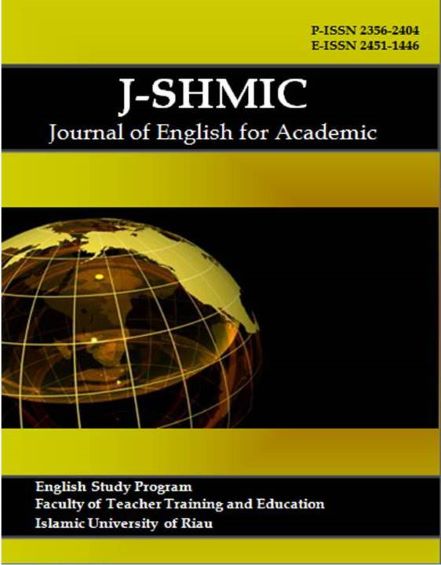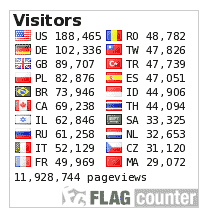Point-Counterpoint Strategy for Better Reading Comprehension on EFL Junior High School Students
Keywords:
Point-Counterpoint Strategy; Reading ComprehensionAbstract
Point-Counterpoint is one of the strategies that can be used to stimulate students and make them free in reading. This study is conducted to reveal the significant difference in reading ability under Point-Counterpoint strategy and conventional technique in class seven students at SMP Negeri 1 Batauga, South Buton regency. The design of this study was a quasi-experimental method. The sample was taken using cluster sampling, in which took class VII-F was selected as an experimental group and class VII-E was a control group. The instruments used were a pretest and a posttest. The results revealed that the average score for the pretest in the experimental group was 47.83, while the average score in the control group was 34.77. The average score for the posttest in the experimental group was 71.13, while it was 58.62 in the control group. Those scores indicated that the students had good reading ability in the experimental group, while the students in the control group had moderate comprehension in reading. The requirement testing outcome informed that the data had a normal distribution and were homogeneous. The hypothesis testing indicated that the tcount was 4.489 and the significant score was 0.000. Both results meant that the Point-Counterpoint strategy was significantly different from a conventional method toward students’ reading comprehension.
Downloads
References
Abdullah, A., Kasim, U., & Marhaban, S. (2021). The use of point counterpoint strategy in teaching EFL students’ writing skill at Madrasah Aliyah Negeri (MAN) 5 Bireun. English Education Journal, 12(3), 511–524.
Alfina, L. (2013). The Effect of Using Point-Counterpoint Strategy toward Reading Comprehension of the Second Year Students at SMAN 3 Siak Regency. UIN Suska.
Alpian, Y., Anggraeni, S. W., Wiharti, U., & Soleha, N. M. (2019). Pentingnya Pendidikan bagi Manusia. Buana Pengabdian, 1(1), 69. https://doi.org/https://doi.org/10.36805/jurnalbuanapengabdian.v1i1.581
Berdiati, I. (2010). Pembelajaran Bahasa Indonesia Berbasis PAKEM (Pembelajaran Aktif, Kreatif, Efektif dan Menyenangkan). Sega Arsy.
Brunner, J. T. (2011). I Don’t Get It!: Helping Students Understand What They Read. Rowman & Littlefield Education.
Cohen, L., Manion, L., & Morrison, K. (2018). Research Methods in Education (Eight). Routledge.
Duha, M. M. (2021). Penerapan Strategi Pembelajaran Point-Counterpoint pada Mata Pelajaran Pendidikan Pancasila dan Kewarganegaraan. Jurnal Education and Development, 9(2), 642–646.
Faharuddin, F., Nur, R., & Ammade, S. (2021). Point-Counter-Point Strategy To Elevate Students’ Writing Performance By Using Video-Blog. Exposure : Jurnal Pendidikan Bahasa Inggris, 10(1), 101–108. https://doi.org/10.26618/exposure.v10i1.5050
Grabe, W., & Stoller, F. L. (2013). Teaching and Researching Reading, Second Edition. In Teaching and Researching Reading, Second Edition (Second). Routledge. https://doi.org/10.4324/9781315833743
Ibhar, M. Z. (2022). Reading Motivation and EFL Learners’ Vocabulary Development Against Interest in Learning English Moderated by Teacher Competence. J-SHMIC : Journal of English for Academic, 9(2), 25–38. https://doi.org/10.25299/jshmic.2022.vol9(2).9823
Mukrimaa, S. S. (2014). 53 Metode Belajar dan Pembelajaran. Universitas Pendidikan Indonesia.
Nurlaili. (2013). The Effect of Using About/Point Strategy toward Reading Comprehension of the Second Year Students of SMAN 3 Siak Regency. UIN Suska.
Nusantara, T. S. (2018). English Comprehension for Junior High School. PT Gramedia Widiasarana Indonesia.
Pristiwanti, D., Badariah, B., Hidayat, S., & Dewi, R. S. (2022). Pengertian Pendidikan. Jurnal Pendidikan Dan Konseling (JPDK), 4(6), 1707–1715.
Rambe, D., & Amri, Z. (2019). Teaching Discussion Text Using Point Counterpoint Method To Improve Speaking Ability Of Senior High School Students. Journal of English Language Teaching, 8(1), 178–186.
Rogers, T. (1990). A point, counterpoint response strategy for complex short stories. Journal of Reading, 34(4), 278–282.
Septia, W. A., Zulianti, H., & Herlisya, D. (2022). About Point Strategy And Its Influence Towards Students’ Reading Comprehension. International Journal Corner of Educational Research, 1(2), 78–86. https://doi.org/10.54012/ijcer.v1i2.89
Suwadi. (2016). Penerapan Strategi Pembelajaran Point-Counterpoint Bervariasi untuk Meningkatkan Daya Kritis dan Hasil Belajar pada Mata Pelajaran PKn Topik Usaha Pembelaan Negara Bagi Siswa Kelas IX E SMP Negeri 1 Mojosongo. Teknodika, 16(1), 69–81. https://doi.org/https://doi.org/10.20961/teknodika.v14i1.34703
Taladngoen, U., Palawatwichai, N., Estaban, R. H., & Phuphawan, N. (2020). A study of factors affecting EFL tertiary students’ reading comprehension ability. Rangsit Journal of Educational Studies, 7(1), 12–21.
Wastuti. (2005). The Effect of Collaborative Point Strategic Reading Toward the Second Year Students’ Reading Comprehension Achievement at SLTP Negeri 20 Pekanbaru. UIN Suska.
Published
How to Cite
Issue
Section
This is an open-access article distributed under the terms of the Creative Commons Attribution-ShareAlike 4.0 International License which permits unrestricted use, distribution, and reproduction in any medium. Users are allowed to read, download, copy, distribute, search, or link to full-text articles in this journal without asking by giving appropriate credit, providing a link to the license, and indicating if changes were made. All of the remixes, transform, or build upon the material must distribute the contributions under the same license as the original.











